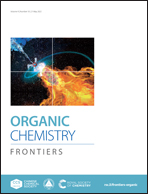C–H benzylation of quinoxalin-2(1H)-ones via visible-light riboflavin photocatalysis†
Abstract
An efficient visible-light promoted riboflavin-catalyzed direct benzylation of substituted quinoxalin-2(1H)-ones for the synthesis of various C3-benzylated quinoxalin-2(1H)-one derivatives has been developed under mild conditions. The present method uses readily available benzyl bromides as alkylating reagents and environmentally friendly and inexpensive riboflavin (vitamin B2) as a green organic photocatalyst. This method opens a new avenue towards C3-benzylated quinoxalin-2(1H)-ones, thus promising their broad applications in pharmaceutical chemistry and synthetic chemistry.



 Please wait while we load your content...
Please wait while we load your content...